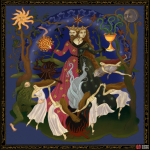Text
In the Czech lands, any practices connected with magic that were intended to harm rather than help (especially by women) were regarded as witchcraft. In the early Middle Ages, witchcraft was divided into white magic – beneficial and associated with healing, and black magic – curses, hexes and abuse of magic for iniquitous purposes. Magic included divination, necromancy, alchemy, herbalism, and entrenched pagan customs and rituals, which had originally constituted an integral part of medieval society.
By the end of the 15th century, efforts to eradicate witchcraft culminated in senseless witch-hunts and persecution of anyone involved with magic. The persecutions peaked around the end of the 16th century, when hundreds of people fell victim to the zeal of the witch-hunters.
As well as the Inquisition, many superstitions and half-truths have arisen concerning witchcraft, though only a few are grounded in truth. Although many were convicted and condemned during the period, most of those accused of heresy or witchcraft escaped unscathed. On the contrary, it was often those who had denounced them, with covetous intent, and whose accusations proved to be false, who were punished. More people fell prey to lynch mobs and fanatical self-proclaimed inquisitors than to institutionalized witch-burnings.


No Comments